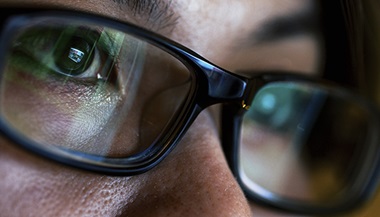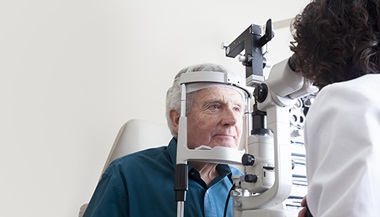Pneumatic Retinopexy
What is pneumatic retinopexy?
Pneumatic retinopexy is a procedure to repair a detached retina and restore vision. Unlike other procedures to treat a detached retina, it often takes place in an office setting.
The retina is a layer of cells at the back of your eye. These cells use light to send visual information to your brain. Retinal detachment happens when part of your retina detaches from the inner wall of the eye. When that happens, your retina does not function normally. If not treated promptly, a retinal detachment can cause permanent vision loss.
If you have pneumatic retinopexy, your eye doctor will inject an expanding gas bubble into your eye. He or she will position you so that the bubble floats over the detached area and pushes it against the back of your eye. Your eye doctor then uses a freezing device to seal the retina against the wall of the eye.
Why might I need pneumatic retinopexy?
Certain factors make it more likely that you will have a retinal detachment. These include:
- Nearsightedness
- Other eye disorders, like uveitis
- Previous cataract surgery
- Increased age
Most of the time, the retinal detachment happens spontaneously, but sometimes an eye injury can cause it as well.
If you have retinal detachment, you will probably need some sort of procedure. You might have an increase in floaters in your eye. These look like little specks or cobwebs that float in your field of vision. These floaters can be so dense that they impair your vision. You might also experience light flashes in your eye or a curtain over your field of vision.
If you have these symptoms, you may need a procedure to reattach your retina. This can reestablish the flow of blood to your retina and restore vision.
Eye doctors sometimes treat retinal detachment with scleral buckling, vitrectomy, or a combination of the two. Pneumatic retinopexy is a less invasive choice, and it may have a slightly lower risk of complications. Pneumatic retinopexy may not be appropriate if you have a complicated tear, or if your tear is present on the lower part of your eye. Ask your eye doctor about the benefits and risks of all your treatment options.
What are the risks of pneumatic retinopexy?
Most people do well with their pneumatic retinopexy, but complications can sometimes occur. Your risks may depend on your age, your medical conditions, and the specifics of your retinal detachment. More common risks of the procedure include:
- Proliferative vitreoretinopathy (a scar like process on the retina that can lead to holes or recurrent detachment)
- Persistent or recurrent detachment of your retina
- Trapped gas in your eye
Some of the less common risks are:
- Folds in your retina
- Inflammation in your eye
- Increase in your eye pressure
- Bleeding in your eye
- Detachment of the layer beneath your retina called the choroid
- New retinal tear
There is also a risk that the retina will detach again and that you will need a repeat procedure.
How do I prepare for pneumatic retinopexy?
Ask your eye doctor what you need to do to prepare for pneumatic retinopexy. Ask whether you need to stop taking any medications before the procedure. You may need to avoid eating anything after midnight, the day before the procedure.
Your eye doctor may want to use special instruments to shine a light in your eye and examine your retina. You may need to have your eyes dilated for the eye exam.
What happens during pneumatic retinopexy?
Talk to eye doctor about what to expect during your procedure. You will probably have pneumatic retinopexy at your doctor’s office. In general, during the procedure:
- You may receive a medication to help you relax, but you will be awake.
- Your eye doctor may give you eye drops to dilate your eye. You’ll also get eye drops to make the area numb.
- Your eye doctor may inject another anesthetic around your eye.
- Your eye doctor may use a syringe to remove some fluid from inside your eye.
- Your eye doctor will inject a bubble into the area near your retina. Your eye doctor may use an ophthalmoscope to make sure the air bubble is in the right place.
- Your eye doctor may use a freezing instrument to help seal retina against the wall of the eye.
- A healthcare provider may apply an antibiotic ointment to your eye to help prevent infection.
- A healthcare provider may patch and cover your eye.
What happens after pneumatic retinopexy?
Ask your eye doctor about what you should expect after your procedure. Plan to have someone go home with you after the procedure.
Be sure to follow your eye doctor’s instructions about eye care. You may need to take eye drops with antibiotics to help prevent infection. Your eye may be a little sore after the procedure, but you should be able to take over-the-counter pain medications. You may need to wear an eye patch for a day or so.
Your eye doctor will give you specific instructions about how to position your head after the procedure. It is important to follow all your eye doctor’s instructions to help reduce your chance for complications. You may need to keep a certain position for 8 hours or more after your pneumatic retinopexy. To avoid complications, you will also need to avoid air travel for a period after the procedure. Ask your eye doctor when it will be safe for you to fly again.
You will need close follow-up care with your eye doctor to see whether the procedure was effective. You may have a scheduled appointment the day after the procedure. Be sure to tell your eye doctor right away if you have decreasing vision or increasing pain or swelling around your eye. If the procedure doesn’t work, you may need to have surgery.
Next steps
Before you agree to the test or the procedure make sure you know:
- The name of the test or procedure
- The reason you are having the test or procedure
- What results to expect and what they mean
- The risks and benefits of the test or procedure
- What the possible side effects or complications are
- When and where you are to have the test or procedure
- Who will do the test or procedure and what that person’s qualifications are
- What would happen if you did not have the test or procedure
- Any alternative tests or procedures to think about
- When and how will you get the results
- Who to call after the test or procedure if you have questions or problems
- How much will you have to pay for the test or procedure






